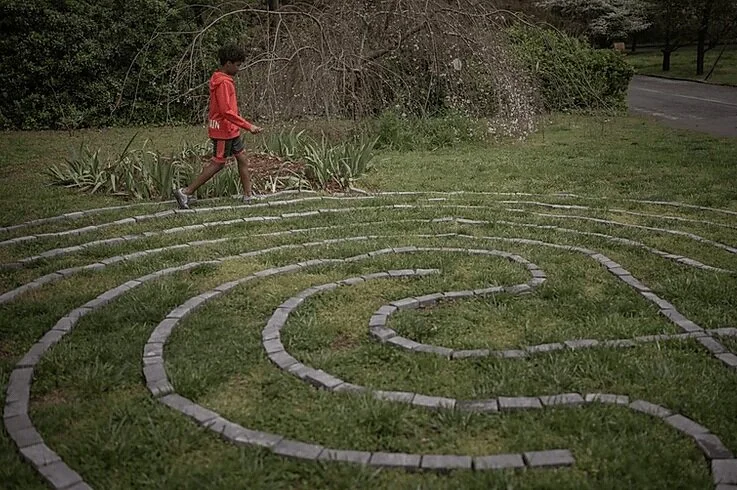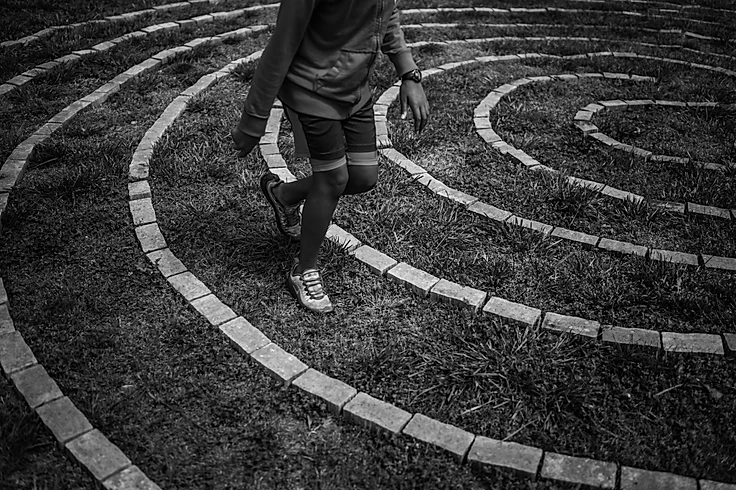Walkers Welcome
The sign at Dancing Bear Labyrinth says: “Walkers Welcome.” The first time I encountered it, years ago, I stood in wonderment for long moments. How could someone simply invite random strangers into their yard? Gratitude overwhelmed me, but the feeling niggled that this was somehow an invasion of privacy.
Fueled by an abundance of suddenly free spring days in the time of Covid-19, I set about building my own front yard labyrinth, a classical seven-circuit, left-handed labyrinth, to be precise. This was mostly for my mental health. An all-absorbing mental and physical challenge that has taken weeks of almost full-time work.
So many of my other neighbors, their patterns suddenly reduced to laps around neighborhood loops, paused to ask what I was doing. “It’s a labyrinth!” I’d respond cheerily, “it’s for walking.” They’d smile and nod, and, ice awkwardly broken, we’d begin exchanging pleasantries and quarantine perspectives.
After they continued on their orbit, conferring with my husband Doug, I’d wonder whether “labyrinth” just didn’t compute, whether they thought I was nuts, and whether I might actually be nuts. Doug mimicked the movie poster for The Hudsucker Proxy, hands on his hips, “You know, for kids!” then dropped into his best Tom Waits growl: “What’s she building in there?”
Labyrinth-building is still an uncommon quest, although they began popping up more regularly after a 1970s renaissance. People began exploring ancient patterns for healing potentials and constructing new sites. They painted portable ones on canvas, and workshops sprang up.
A friend connected me to someone who has been at the forefront of both The Labyrinth Society and Veriditas. We spoke by phone one morning while I dug shallow trenches to lay the pavers. The desire that drove her to construct one in her backyard spoke deeply to my own frenzy, and she related incredible stories of unfolding a cloth labyrinth in the wake of hurricanes and Cold War divides. “I like to explain it as a ‘walking meditation,’” she advised, to convey the serenity it can bring while sidestepping any religious preconceptions.
So I put a post up in our neighborhood forum on social media, inviting walkers. And that’s when the crystallized magic began to bloom.
Blearily checking into another home office work day, mist occasionally thickening into drizzle, a flash of color alerted me to people in my yard. My neighbor Kristin, a photographer blogging about life under lockdown, captured these shots of her son on his first walk.
Taking a Walking Meditation
Photo Credit: Kristin Watkins
Spellbound, I watched her family’s playful wonder. At no time did I feel the boundaries of my yard transgressed. Instead, I worried briefly whether I’d invaded their privacy. Ultimately, I settled on feeling gratitude for this gift of being a witness.
Find a time and a space to become conscious of walking, even in a circle around the same old room.
CRAFT A RADICAL RITUAL: BECOME PRESENT TO YOUR SENSES AND REGISTER WHAT EACH ONE IS TELEGRAPHING. HOW DO YOUR EMOTIONS INHABIT YOUR BODY? YOUR THOUGHTS? BECOME PRESENT TO THE QUALITY OF YOUR BREATH.
You don’t have to walk a labyrinth, strictly speaking, you can skip, dance, crawl, cut across, spin, or run it like a superhero in a mask and cape like another neighbor’s son did the other day. You don’t even have to move through it to benefit: Witnessing walkers can be just as meditative.
For these powerful reasons—and for every connection that crosses the chasms between us—I’m growing comfortably fond of the phrase “Walkers welcome.”
Walkers Welcome
Photo Credit: Kristin Watkins



